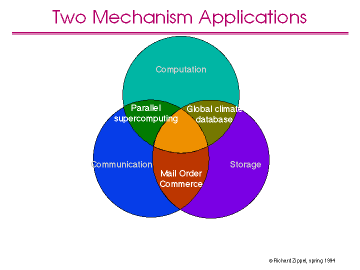
Back to the previous slide, on to the next slide or up to the overview
The next generation of applications blends together two different mechanisms. We are just starting to understand the problems that arise with these types of systems, what the proper abstractions are, and how to construt them.
For instance, climate modeling couples gigantic weather databases generated from satellite observation with the computation prowess of super-computers. Without super-computers to process the satellite imagery and perform high level searches and correlations, the satellite data would be of limited usefulness. The raw data provided by the satellites is the starting point for the super-computing computations used to predicate weather patterns. The two components, massive data storage and super-computing together permit accurate weather forecasting and climate modeling.
Combining computing with communications we have parallel computing technology. One of the reasons that parallel super-computers have been so slow in coming is that is so difficult effectively couple communications and computation issues. The first successful attempts at parallel machines used very stylized communications approaches, e.g. vector computing.
A typical coupling of communications and storage technologies is represented by the huge mail-order businesses that have sprung up in recent years. Without that combination of the telephone communications systems, the electronic distributed electronic databases and Federal Express they could not exist. Similarly the on-demand video systems actively being discussed merge (cable) communications with the huge continuous media databases that serve as movie repositories.
Richard Zippel